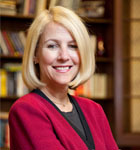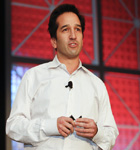Mike Relich made about 150 bucks and a case of beer on his first computer programming job. He was a college kid toting a Commodore 64 and just beginning to dabble in computers. Relich had always been a tinkerer, buying old bikes at police auctions and fixing them up as a kid, so when the owner of the local liquor store complained about keeping track of his inventory, Relich offered to make him a deal.
Considering those humble beginnings, the chief information officer of GUESS?, Inc. has come a long way. And in his eight years with the clothing giant, he has helped the company grow from a wholesaler netting $640 miller per year to a retailer with stores in 26 countries that ropes in $2.8 billion annually. One big reason for that growth is the commitment to efficiency that Relich and his team have made and carried out through the innovative use of technology.
Relich got his start in retail tagging along with his brother to an inventory job at Sears, and he’s been on a steady path toward GUESS ever since. His first step was a bit lateral, but would be invaluable in the future. After high school, Relich decided to join his parents, who had moved to Korea, and attended the University of Maryland’s Korean campus. As an anthropology major, Relich would study sites of new development and ensure contractors didn’t unknowingly excavate a burial ground when putting in strip malls. After spending some time in the field, he realized a life of academia and low pay wouldn’t be enough. He took a basic programming class and was so intrigued by his project, writing a blackjack computer game, that when he found out people got paid to do it, he switched his major to business information systems.

After graduating from California State University, Long Beach, finding a job in the high-rises of Los Angeles proved harder than making a beer run. For months, Relich knocked on doors, résumé in hand, only to be turned away in reflection of the struggling, early 1980s economy. For a moment he even considered joining the Navy as a pilot, which may have been motivated by a dream to emulate Top Gun’s Maverick. Luckily, Relich got an offer from Carter Hawley Hale Stores, which, at the time, was the second-largest retailer behind Macy’s owner Federated Department Stores, Inc.
As Relich rose from trainee to senior programmer to technology specialist, he developed a reputation for problem solving. “I was considered very much a tech-head,” he recalls. “I remember downloading Mozilla on my laptop and showing it to my dad, thinking it was the greatest thing, and he didn’t even know what it was.” To his father’s credit, Internet use by common folk was incredibly low at the time, and rather than the websites people are familiar with today, users in the know with a dial-up connection had to phone in to each bulletin board on which they wanted to participate.
At work, Relich received a similar reaction when he suggested putting Neiman Marcus credit-card statements online. It would have theoretically allowed card holdersto pull up their own accounts,” Relich explains. “We could have done e-commerce before it was called e-commerce. I showed my managers, but people thought I was crazy.”

Relich continued to write programs for Carter Hawley Hale that maintained credit card portfolios, logged loyalty points, and tracked spending behaviors. It was revolutionary stuff, but Relich was getting bored. “At the end of the day, it got repetitive putting instructions into a machine,” he says. “What intrigued me was the application of programming to business.” A trip to Dallas rekindled his excitement for his skill when he walked into a Neiman Marcus branch and saw 350 people plugging information into the system he had written. “It blew me away and changed my perspective,” Relich says. “I started thinking that I wanted to be more involved in how decisions were made and how we applied our technology.”
He gained that responsibility when he changed jobs and became the assistant vice president of system development at HomeBase, one of the first big box, home-improvement stores. The store was being held back by an obsolete system, but Relich had an ambitious yet risky plan: he proposed a complete transition to client/server-based software and architecture without the help of a contracted company such as IBM. While mercenaries came in to handle specific portions of the changeover, all of the work was done internally—a first for any Retek implementation. The new website was a success. But never one to get comfortable, Relich looked for another challenge and found it in San Francisco.
Working for a startup had been on Relich’s radar for a while, so when a friend told him about an IBM-funded Internet project getting underway, Relich hopped on board Freeboarders, an online marketplace where retailers and manufacturers from around the world could bid on goods and services. It was 2001 and still the heyday of dot-coms. For a year before the industry bust, Relich would fly from Southern California to Northern California each week. The hiring frenzy among Internet job seekers was so competitive that if Relich passed on someone they could leave his office and almost surely find another the same day. What separated Freeboarders from many of its neighbors, though, were its niche service and international scope. It was through those international connections that Relich was able to leverage himself for his next job.
When Freeboarders merged with another company, Relich looked for new opportunities yet again. He found them at Wet Seal, Inc. where the retailer was struggling with its retail software—the same software he had implemented at HomeBase. Wet Seal used Freeboarders to connect with a Chinese company, and after speaking with its president, Relich secured an interview with the Wet Seal CEO and was hired within a week. With a team of former colleagues he brought from HomeBase and Broadway Stores, Inc.—formerly Carter Hawley Hale—Relich cleaned up the company’s systems and set it up for a profitable future. “We were getting more innovative,” he explains. “I wasn’t chasing and fixing problems, but rather putting in solutions for the business. We put in a new HR system and worked with replenishment. We were building up their infrastructure.”
Despite the improvements, Wet Seal began facing some economic adversity. Considering his options, Relich met with GUESS founders, the Marciano brothers, and the prospect of a more complex business and the challenge of bringing yet another large company through a transition convinced him to take the bait.
Relich was met with a tall maintenance order before he could get innovative at GUESS. In his early days, he would spend 15 hours a week listening to complaints from wholesalers and retailers who shared warehouse space and couldn’t determine ownership of the goods inside. It became clear that a more efficient method of sorting was needed. Once inventory was cleaned up, GUESS could focus on growth, and Relich helped lay the foundation in Europe and Asia—in fact, he led infrastructure development for the sourcing office in China. And putting his years of living abroad to good use, Relich fit in well with partners in Korea and became friends with the GUESS president there. “The cultural fit was great,” he remembers. “I knew how to cook some of the food and could speak conversational Mandarin and Korean. It was fun building a team in Europe and Korea, and a satellite team in Hong Kong.”
The innovation began by solving a physical problem with a virtual answer. “One of the things I believe is that it can be wasteful to spend money on transactional systems,” Relich says. “Your decision makers care about the data.”
The decision makers in this case were buyers for retail stores, and before the introduction of GUESS’s business-intelligence app, they were carrying all their data around in five-inch binders written in eight-point font, not to mention that the lag time caused the information to be outdated. “If we could combine rich data and presentation, that would be perfect,” Relich thought. “Merchants could get to their data with a few clicks. We could unshackle them from these huge binders and give them a 20th century app.” The resulting business-intelligence app was a hit, and soon other companies were asking to use the software. In 2010, the Data Warehousing Institute recognized GUESS with an award for Best Practices in Business Intelligence, and, in 2011, the organization lauded GUESS with an award for Emerging Technologies and Methods.
In the same vein, Relich applied his data-to-the-decision-makers philosophy to another application, this time based on consumer input. “I wanted to make a GUESS app so that when people agree to let us look at their Facebook data, we could combine their loyalty data,” Relich explains. On the road to that reality, GUESS considered Alert, an app produced by Micro Strategies Inc., the company whose software helped them launch the merchant app. Alert would download users’ Facebook data to the cloud, but stopped there, and Relich found that data to be a dead end. “It treated all ‘likes’ equally, and all are not created equal,” he says. “Someone could just casually ‘like’ us to impress their girlfriend,” essentially telling GUESS about an uninterested consumer.
With a little tweaking, Relich’s vision was realized. “Now I can look at my best customers and see in Facebook which brands they like, music they listen to, if they travel, and tie it to transactions,” he says. “I can segment my customers by behavior and Facebook attributions and give them
information that’s relevant to them.”
Though only about 30,000 people downloaded the consumer app in its pilot test, the functionality promises much more tailored and valuable data for GUESS, as well as its customers, who are able to make purchases right from the app and view “look books” for fashion ideas.
In his 29-year career, Mike Relich has gone from self-taught programmer to retail-technology visionary. Even with everything he’s done, he is still excited about the changes he sees in the virtual world’s future. And he hopes to keep harnessing these innovations for GUESS. “When I started at GUESS, my goal was to convert the business from wholesale-centric to retail-centric and put the best growth systems in place,” Relich says with satisfaction. “Technology is always evolving, but I think we’ve succeeded.”















